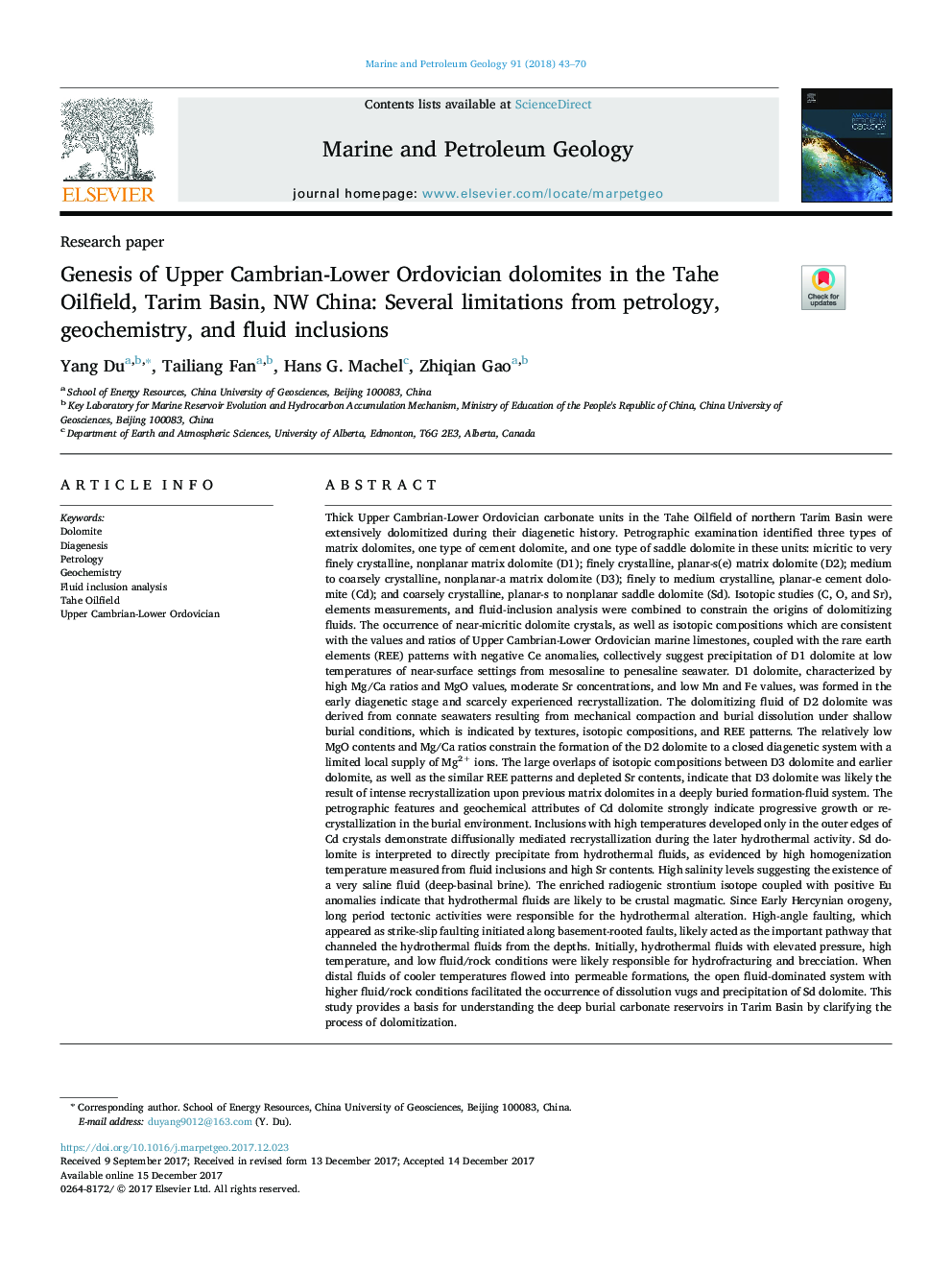| کد مقاله | کد نشریه | سال انتشار | مقاله انگلیسی | نسخه تمام متن |
|---|---|---|---|---|
| 8909150 | 1637134 | 2018 | 28 صفحه PDF | دانلود رایگان |
عنوان انگلیسی مقاله ISI
Genesis of Upper Cambrian-Lower Ordovician dolomites in the Tahe Oilfield, Tarim Basin, NW China: Several limitations from petrology, geochemistry, and fluid inclusions
ترجمه فارسی عنوان
پیدایش دولومیتهای اردوویک پایین کمبریج بالا در میدان نفتی تاه، حوضه تاریم، جنوب غربی چین: محدودیت های متعددی از پترولوژی، ژئوشیمی و ورودی های مایع
دانلود مقاله + سفارش ترجمه
دانلود مقاله ISI انگلیسی
رایگان برای ایرانیان
کلمات کلیدی
موضوعات مرتبط
مهندسی و علوم پایه
علوم زمین و سیارات
زمین شناسی اقتصادی
چکیده انگلیسی
Thick Upper Cambrian-Lower Ordovician carbonate units in the Tahe Oilfield of northern Tarim Basin were extensively dolomitized during their diagenetic history. Petrographic examination identified three types of matrix dolomites, one type of cement dolomite, and one type of saddle dolomite in these units: micritic to very finely crystalline, nonplanar matrix dolomite (D1); finely crystalline, planar-s(e) matrix dolomite (D2); medium to coarsely crystalline, nonplanar-a matrix dolomite (D3); finely to medium crystalline, planar-e cement dolomite (Cd); and coarsely crystalline, planar-s to nonplanar saddle dolomite (Sd). Isotopic studies (C, O, and Sr), elements measurements, and fluid-inclusion analysis were combined to constrain the origins of dolomitizing fluids. The occurrence of near-micritic dolomite crystals, as well as isotopic compositions which are consistent with the values and ratios of Upper Cambrian-Lower Ordovician marine limestones, coupled with the rare earth elements (REE) patterns with negative Ce anomalies, collectively suggest precipitation of D1 dolomite at low temperatures of near-surface settings from mesosaline to penesaline seawater. D1 dolomite, characterized by high Mg/Ca ratios and MgO values, moderate Sr concentrations, and low Mn and Fe values, was formed in the early diagenetic stage and scarcely experienced recrystallization. The dolomitizing fluid of D2 dolomite was derived from connate seawaters resulting from mechanical compaction and burial dissolution under shallow burial conditions, which is indicated by textures, isotopic compositions, and REE patterns. The relatively low MgO contents and Mg/Ca ratios constrain the formation of the D2 dolomite to a closed diagenetic system with a limited local supply of Mg2+ ions. The large overlaps of isotopic compositions between D3 dolomite and earlier dolomite, as well as the similar REE patterns and depleted Sr contents, indicate that D3 dolomite was likely the result of intense recrystallization upon previous matrix dolomites in a deeply buried formation-fluid system. The petrographic features and geochemical attributes of Cd dolomite strongly indicate progressive growth or recrystallization in the burial environment. Inclusions with high temperatures developed only in the outer edges of Cd crystals demonstrate diffusionally mediated recrystallization during the later hydrothermal activity. Sd dolomite is interpreted to directly precipitate from hydrothermal fluids, as evidenced by high homogenization temperature measured from fluid inclusions and high Sr contents. High salinity levels suggesting the existence of a very saline fluid (deep-basinal brine). The enriched radiogenic strontium isotope coupled with positive Eu anomalies indicate that hydrothermal fluids are likely to be crustal magmatic. Since Early Hercynian orogeny, long period tectonic activities were responsible for the hydrothermal alteration. High-angle faulting, which appeared as strike-slip faulting initiated along basement-rooted faults, likely acted as the important pathway that channeled the hydrothermal fluids from the depths. Initially, hydrothermal fluids with elevated pressure, high temperature, and low fluid/rock conditions were likely responsible for hydrofracturing and brecciation. When distal fluids of cooler temperatures flowed into permeable formations, the open fluid-dominated system with higher fluid/rock conditions facilitated the occurrence of dissolution vugs and precipitation of Sd dolomite. This study provides a basis for understanding the deep burial carbonate reservoirs in Tarim Basin by clarifying the process of dolomitization.
ناشر
Database: Elsevier - ScienceDirect (ساینس دایرکت)
Journal: Marine and Petroleum Geology - Volume 91, March 2018, Pages 43-70
Journal: Marine and Petroleum Geology - Volume 91, March 2018, Pages 43-70
نویسندگان
Yang Du, Tailiang Fan, Hans G. Machel, Zhiqian Gao,
